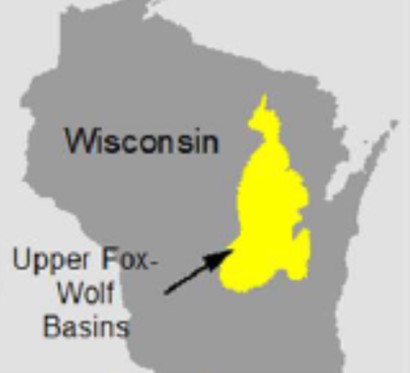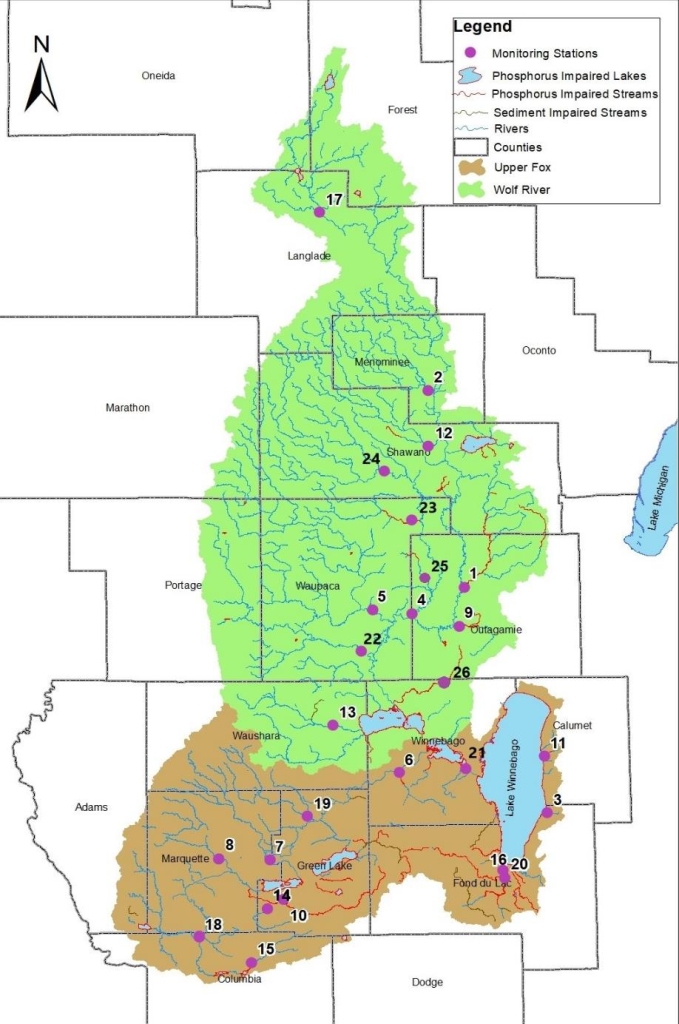Upper Fox and Wolf River Basins Volunteer Monitoring Program
Upper Fox and Wolf Rivers TMDL

In February 2020, the U.S. Environmental Protection Agency (EPA) approved the Upper Fox and Wolf River Basins Total Maximum Daily Load (TMDL). The TMDL set targets to improve surface water quality by reducing phosphorus and sediment loading in the watershed. To help achieve some of the monitoring goals outlined in the TMDL, the Upper Fox and Wolf River Basins Volunteer Monitoring Program was created in 2020.
Want to get involved? The DNR is always looking for new, energetic and motivated volunteers. If you are interested in volunteering, please contact Katherine Rynish, Upper Fox and Wolf River Basins Volunteer Monitoring Program Coordinator.
About the Volunteer Program
The program relies on volunteers to collect surface water samples monthly. Volunteers follow Water Action Volunteer (WAV) sampling protocols and report to the program coordinator to ensure consistency is being met in each sample. Samples are sent to the Wisconsin State Lab of Hygiene for sample analysis and results are sent to the program coordinator for data analysis. The DNR provides all sampling equipment, shipping materials and training.
Volunteer Program Specifics
Twenty-six monitoring sites on 24 different streams are sampled monthly between May and October. This timeframe is the primary algae and macrophyte growing season. Volunteers collect surface water samples which are analyzed for Total Phosphorus (TP), Total Suspended Solids (TSS), Dissolved Reactive Phosphorus (DRP) and Total Nitrogen (TN). In addition to collecting water samples, volunteers also measure streamflow and turbidity.
Nutrient And Sediment Impacts
To meet Wisconsin’s water quality criteria, streams must have a median phosphorus level less than 0.075 mg/L and rivers must have a median below 0.1 mg/L. Waters that do not meet criteria are classified as impaired. Thirteen of the 24 sampling streams are impaired due to excess total phosphorus (TP) and/or total suspended solids (TSS). Excessive phosphorus and sediment works its way through the entire river system and can have major impacts on river health. Some of the impacts include more frequent algal blooms, reduced fish habitat and low aquatic plant density - these impacts affect fishing, swimming, recreational activities and environmental conditions.
Program Goals
- Engage the public in citizen science and bring public awareness to the water quality issues in the basin.
- Collect accurate and reliable data.
- Evaluate nutrient and sediment concentrations in the streams to the Upper Fox River, Wolf River and Lake Winnebago basins.
- Monitor the health of the watershed over time at a regional scale.
- Evaluate the long-term effectiveness of implementation of the Upper Fox and Wolf River Basins TMDL.
Streams
- Rat River
- East Branch Fond Du Lac River
- Mud Creek
- Pipe Creek
- West Branch Fond Du Lac River
- Grand River
- Waukau Creek
- Bear Creek
- Embarrass River
- Little Wolf River
- Shioc River
- Mecan River
- Montello River
- Red River
- Pine River
- Belle Foundation Creek
- Neenah Creek
- White River
- Fox River
- Wolf River
- West Branch Wolf River
- Pigeon River
- Sawyer Creek
- Waupaca River
Results
- Interactive Water Quality Data Excel Sheet [xlsx]
- 2024 Upper Fox and Wolf River Basins Volunteer Monitoring Annual Report
- 2024 Upper Fox and Wolf River Basins Volunteer Monitoring Summary
- 2023 Upper Fox and Wolf River Basins Volunteer Monitoring Annual Report
- 2023 Upper Fox and Wolf River Basins Volunteer Monitoring Summary
- 2022 Upper Fox and Wolf River Basins Volunteer Monitoring Annual Report
- 2022 Upper Fox and Wolf River Basins Volunteer Monitoring Summary
- 2020 Upper Fox and Wolf River Basins Volunteer Monitoring Annual Report
Volunteer Resources
- Upper Fox and Wolf River Basins Volunteer Monitoring Fact Sheet
- Upper Fox and Wolf River Basins Volunteer Manual
- Water Action Volunteer (WAV)
- Thanks to WAV for funding and support of the Northeast Lakeshore Volunteer Monitoring Program
- Streamflow Worksheet
- Volunteer Agreement Form

